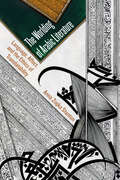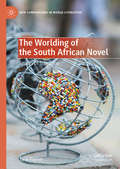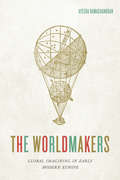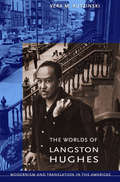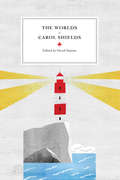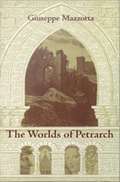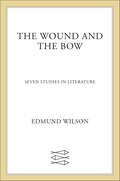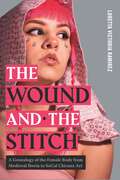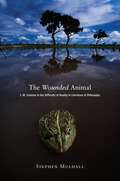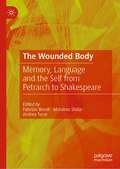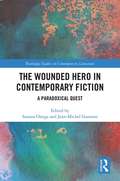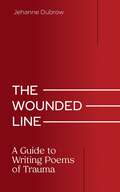- Table View
- List View
The Worlding of Arabic Literature: Language, Affect, and the Ethics of Translatability
by Anna Ziajka StantonCritics have long viewed translating Arabic literature into English as an ethically fraught process of mediating between two wholly incommensurable languages, cultures, and literary traditions. Today, Arabic literature is no longer “embargoed” from Anglophone cultural spaces, as Edward Said once famously claimed that it was. As Arabic literary works are translated into English in ever-greater numbers, what alternative model of translation ethics can account for this literature’s newfound readability in the hegemonic language of the world literary system? The Worlding of Arabic Literature argues that an ethical translation of a work of Arabic literature is one that transmits the literariness of the source text by engaging new populations of readers via a range of embodied and sensory effects. The book proposes that when translation is conceived of not as an exchange of semantic content but as a process of converting the affective forms of one language into those of another, previously unrecognized modalities of worldliness open up to the source text.In dialogue with a rich corpus of Arabic aesthetic and linguistic theory as well as contemporary scholarship in affect theory, translation theory, postcolonial theory, and world literature studies, this book offers a timely and provocative investigation of how an important literary tradition enters the world literary system.The Worlding of Arabic Literature: Language, Affect, and the Ethics of Translatability is available from the publisher on an open-access basis.
The Worlding of the South African Novel: Spaces of Transition (New Comparisons in World Literature)
by Jane PoynerThe Worlding of the South African Novel develops from something of a paradox: that despite momentous political transition from apartheid to democracy, little in South Africa’s socio-economic reality has actually changed. Poyner discusses how the contemporary South African novel engages with this reality. In forms of literary experiment, the novels open up intellectual spaces shaping or contesting the idea of the “new South Africa”. The mediatising of truth at the TRC hearings, how best to deal with a spectacular yet covert past, the shaping for “unimagined communities” of an inclusive public sphere, HIV/AIDS as the preeminent site testing capitalist modernity, white anxieties about land reform, disease as environmental injustice and the fostering of an enabling restorative cultural memory: Poyner argues that through these key nodes of intellectual thought, the novels speak to recent debates on world-literature to register the “shock” of an uneven modernity produced by a capitalist world economy.
The Worldmakers: Global Imagining in Early Modern Europe
by Ayesha RamachandranIn this beautifully conceived book, Ayesha Ramachandran reconstructs the imaginative struggles of early modern artists, philosophers, and writers to make sense of something that we take for granted: the world, imagined as a whole. Once a new, exciting, and frightening concept, “the world” was transformed in the sixteenth and seventeenth centuries. But how could one envision something that no one had ever seen in its totality? The Worldmakers moves beyond histories of globalization to explore how “the world” itself—variously understood as an object of inquiry, a comprehensive category, and a system of order—was self-consciously shaped by human agents. Gathering an international cast of characters, from Dutch cartographers and French philosophers to Portuguese and English poets, Ramachandran describes a history of firsts: the first world atlas, the first global epic, the first modern attempt to develop a systematic natural philosophy—all part of an effort by early modern thinkers to capture “the world” on the page.
The Worlds Of Langston Hughes
by Vera M. KutzinskiThe poet Langston Hughes was a tireless world traveler and a prolific translator, editor, and marketer. Translations of his own writings traveled even more widely than he did, earning him adulation throughout Europe, Asia, and especially the Americas. In The Worlds of Langston Hughes, Vera Kutzinski contends that, for writers who are part of the African diaspora, translation is more than just a literary practice: it is a fact of life and a way of thinking. Focusing on Hughes's autobiographies, translations of his poetry, his own translations, and the political lyrics that brought him to the attention of the infamous McCarthy Committee, she shows that translating and being translated-and often mistranslated-are as vital to Hughes's own poetics as they are to understanding the historical network of cultural relations known as literary modernism. As Kutzinski maps the trajectory of Hughes's writings across Europe and the Americas, we see the remarkable extent to which the translations of his poetry were in conversation with the work of other modernist writers. Kutzinski spotlights cities whose role as meeting places for modernists from all over the world has yet to be fully explored: Madrid, Havana, Buenos Aires, Mexico City, and of course Harlem. The result is a fresh look at Hughes, not as a solitary author who wrote in a single language, but as an international figure at the heart of a global intellectual and artistic formation.
The Worlds of Carol Shields (Reappraisals: Canadian Writers)
by David Staines"Carol was a very fine writer and a remarkable human being, a wonderful person whose work I closely followed for more than 20 years. I interviewed her frequently over those years, with virtually every work she produced —novel, radio drama, play, book of stories. So I had a good sense of the span of her work and also her evolution as a stylist. But the key reason I wanted to make a book focusing on her life and work is that we were friends."—Eleanor WachtelThis book strikes the right balance between intimate accounts and literary analysis. It opens with reminiscences by close friend Eleanor Wachtel, which are followed by a study of Shields’ poetry by her daughter and grandson, then by various aspects of her fiction, including a detailed examination of her plays. It closes with reminiscences by four close friends: Jane Urquhart, Joan Clark, Wayson Choy and Martin Levin.The 23 contributors offer new insights, new theories, and new perspectives about Shields’ illuminating career. Only one piece—her obituary written by Margaret Atwood—has been previously published.
The Worlds of Petrarch
by Giuseppe MazzottaAt the center of Petrarch's vision, announcing a new way of seeing the world, was the individual, a sense of the self that would one day become the center of modernity as well. This self, however, seemed to be fragmented in Petrarch's work, divided among the worlds of philosophy, faith, and love of the classics, politics, art, and religion, of Italy, France, Greece, and Rome. In recent decades scholars have explored each of these worlds in depth. In this work, Giuseppe Mazzotta shows for the first time how all these fragmentary explorations relate to each other, how these separate worlds are part of a common vision. Written in a clear and passionate style, The Worlds of Petrarch takes us into the politics of culture, the poetic imagination, into history and ethics, art and music, rhetoric and theology. With this encyclopedic strategy, Mazzotta is able to demonstrate that the self for Petrarch is not a unified whole but a unity of parts, and, at the same time, that culture emerges not from a consensus but from a conflict of ideas produced by opposition and dark passion. These conflicts, intrinsic to Petrarch's style of thought, lead Mazzotta to a powerful rethinking of the concepts of "fragments" and "unity" and, finally, to a new understanding of the relationship between them. Essential to students of Medieval and Renaissance literature, this book will engage anyone interested in the development of modernity as it has evolved in culture and is understood today.
The Wound and the Bow: Seven Studies in Literature (Library Of America Edmund Wilson Edition Ser.)
by Edmund WilsonIn this classic work, “the greatest literary critic of the 20th century” probes the lives and works of seven great writers (New York Magazine).Combining biographical and critical sketches, Edmund Wilson searches for the wellspring of artistic genius in this series of seven essays. His wide-ranging subjects include Charles Dickens, Rudyard Kipling, Edith Wharton, Ernest Hemingway, James Joyce, Jacques Casanova, and Sophocles.The first two studies, of Charles Dickens and Rudyard Kipling, reveal how in each case an unhappy childhood later resulted in mature artistic works. Expanding on this theme in succeeding chapters, Wilson captures the essence of his thesis in the mythical story of Philoctetes, as recounted in the final essay.The legendary Greek archer was bitten by snake and then afflicted with an incurable, malodorous wound that would not heal. After first being banished, the injured hero was later sought out by his fellow warriors for his prowess with a magic bow, and his skill was ultimately key to the Greek victory at Troy.“In the best tradition of literary criticism . . . combines exact information with shrewd and searching penetration into the personal life of the artist.” —The New York Times
The Wound and the Stitch: A Genealogy of the Female Body from Medieval Iberia to SoCal Chicanx Art (RSA Series in Transdisciplinary Rhetoric)
by Loretta Victoria RamirezThe Wound and the Stitch traces a history of imagery and language centered on the concept of woundedness and the stitching together of fragmented selves. Focusing particularly on California and its historical violences against Chicanx bodies, Loretta Victoria Ramirez argues that woundedness has become a ubiquitous and significant form of Chicanx self-representation, especially in late twentieth-century print media and art.Ramirez maps a genealogy of the female body from late medieval Iberian devotional sculptures to contemporary strategies of self-representation. By doing so, she shows how wounds—metaphorical, physical, historical, and linguistic—are inherited and manifested as ongoing violations of the body and othered forms of identity. Beyond simply exposing these wounds, however, Ramirez also shows us how they can be healed—or rather stitched. Drawing on Mesoamerican concepts of securing stability during lived turmoil, or nepantla, Ramirez investigates how creators such as Cherríe Moraga, Renee Tajima-Peña, Guillermo Gómez-Peña, and Amalia Mesa-Bains repurpose the concept of woundedness to advocate for redress and offer delicate, ephemeral moments of healing.Positioning woundedness as a potent method to express Chicanx realities and transform the self from one that is wounded to one that is stitched, this book emphasizes the necessity of acknowledgment and ethical restitution for colonial legacies. It will be valued by scholars and students interested in the history of rhetorics, twentieth-century Chicanx art, and Latinx studies.
The Wounded Animal: J. M. Coetzee and the Difficulty of Reality in Literature and Philosophy
by Stephen MulhallIn 1997, the Nobel Prize-winning novelist J. M. Coetzee, invited to Princeton University to lecture on the moral status of animals, read a work of fiction about an eminent novelist, Elizabeth Costello, invited to lecture on the moral status of animals at an American college. Coetzee's lectures were published in 1999 as The Lives of Animals, and reappeared in 2003 as part of his novel Elizabeth Costello; and both lectures and novel have attracted the critical attention of a number of influential philosophers--including Peter Singer, Cora Diamond, Stanley Cavell, and John McDowell. In The Wounded Animal, Stephen Mulhall closely examines Coetzee's writings about Costello, and the ways in which philosophers have responded to them, focusing in particular on their powerful presentation of both literature and philosophy as seeking, and failing, to represent reality--in part because of reality's resistance to such projects of understanding, but also because of philosophy's unwillingness to learn from literature how best to acknowledge that resistance. In so doing, Mulhall is led to consider the relations among reason, language, and the imagination, as well as more specific ethical issues concerning the moral status of animals, the meaning of mortality, the nature of evil, and the demands of religion. The ancient quarrel between philosophy and literature here displays undiminished vigor and renewed significance.
The Wounded Body: Memory, Language and the Self from Petrarch to Shakespeare
by Fabrizio Bondi Massimo Stella Andrea TorreThis edited collection explores the image of the wound as a ‘cultural symptom’ and a literary-visual trope at the core of representations of a new concept of selfhood in Early Modern Italian and English cultures, as expressed in the two complementary poles of poetry and theatre. The semantic field of the wounded body concerns both the image of the wound as a traumatic event, which leaves a mark on someone’s body and soul (and prompts one to investigate its causes and potential solutions), and the motif of the scar, which draws attention to the fact that time has passed and urges those who look at it to engage in an introspective and analytical process. By studying and describing the transmission of this metaphoric paradigm through the literary tradition, the contributors show how the image of the bodily wound—from Petrarch’s representation of the Self to the overt crisis that affects the heroes and the poetic worlds created by Ariosto and Tasso, Spenser and Shakespeare—could respond to the emergence of Modernity as a new cultural feature.
The Wounded Hero in Contemporary Fiction: A Paradoxical Quest (Routledge Studies in Contemporary Literature)
by Susana Onega Jean-Michel GanteauThe Wounded Hero in Contemporary Fiction tracks the emergence of a new type of physically and/or spiritually wounded hero(ine) in contemporary fiction. Editors, Susana Onega and Jean-Michel Ganteu bring together some of the top minds in the field to explore the paradoxical lives of these heroes that have embraced, rather than overcome, their suffering, alienation and marginalisation as a form of self-definition.
The Wounded Line: A Guide to Writing Poems of Trauma (Writing From Trauma Series)
by Jehanne DubrowA writing guide to processing trauma through the poetic form, Jehanne Dubrow, a well respected writer, speaker, guide, and spouse of a career military officer, offers an experienced and knowledgeable voice to aspiring writers and those working through trauma.In this accessible and inspiring guide, acclaimed writer Jehanne Dubrow draws on how the study of trauma has defined both her creative work and her teaching. The Wounded Line, the first craft-based writing book of its kind, is grounded not only in research but also in heart, in the belief that even our deepest hurts can find a lyric form. Leading poets through a series of practical approaches to representing pain on the page, Dubrow provides readers with narrative techniques, rhetorical structures, and formal strategies that can be applied to any trauma, from the global and the historical to the intimate and the personal. The Wounded Line encourages poets at all stages to address the difficult, discomfiting questions that ache within each of us.
The Wounded Storyteller: Body, Illness & Ethics
by Arthur W. FrankUpdated second edition: “A bold and imaginative book which moves our thinking about narratives of illness in new directions.” —Sociology of Heath and IllnessSince it was first published in 1995, The Wounded Storyteller has occupied a unique place in the body of work on illness. A collective portrait of a so-called “remission society” of those who suffer from illness or disability, as well as a cogent analysis of their stories within a larger framework of narrative theory, Arthur W. Frank’s book has reached a large and diverse readership including the ill, medical professionals, and scholars of literary theory.Drawing on the work of such authors as Oliver Sacks, Anatole Broyard, Norman Cousins, and Audre Lorde, as well as from people he met during the years he spent among different illness groups, Frank recounts a stirring collection of illness stories, ranging from the well-known—Gilda Radner’s battle with ovarian cancer—to the private testimonials of people with cancer, chronic fatigue syndrome, and disabilities. Their stories are more than accounts of personal suffering: They abound with moral choices and point to a social ethic.In this new edition Frank adds a preface describing the personal and cultural times when the first edition was written. His new afterword extends the book’s argument significantly, discussing storytelling and experience, other modes of illness narration, and a version of hope that is both realistic and aspirational. Reflecting on his own life during the creation of the first edition and the conclusions of the book itself, he reminds us of the power of storytelling as way to understand our own suffering.“Arthur W. Frank’s second edition of The Wounded Storyteller provides instructions for use of this now-classic text in the study of illness narratives.” —Rita Charon, author of Narrative Medicine“Frank sees the value of illness narratives not so much in solving clinical conundrums as in addressing the question of how to live a good life.” —Christianity Today
The Wounded Surgeon: The Poetry of Lowell, Bishop, Berryman, Jarrell, Schwartz, and Plath
by Adam Kirsch"One of the most promising young poet-critics in America" (Los Angeles Times) examines a revolutionary generation of poets. Robert Lowell, Elizabeth Bishop, Sylvia Plath, John Berryman, Randall Jarrell, and Delmore Schwartz formed one of the great constellations of talent in American literature. In the decades after World War II, they changed American poetry forever by putting themselves at risk in their poems in a new and provocative way. Their daring work helped to inspire the popular style of poetry now known as "confessional." But partly as a result of their openness, they have become better known for their tumultuous lives--afflicted by mental illness, alcoholism, and suicide--than for their work. This book reclaims their achievement by offering critical "biographies of the poetry"--tracing the development of each poet's work, exploring their major themes and techniques, and examining how they transformed life into art. An ideal introduction for readers coming to these major American poets for the first time, it will also help veteran readers to appreciate their work in a new light.
The Wreckage of Intentions: Projects in British Culture, 1660-1730 (Alembics: Penn Studies in Literature and Science)
by David AlffThe seventeenth and eighteenth centuries in Britain saw the proposal of so many endeavors called "projects"—a catchphrase for the daring, sometimes dangerous practice of shaping the future—that Daniel Defoe dubbed his era a "Projecting Age." These ideas spanned a wide variety of scientific, technological, and intellectual interventions intended for the betterment of England. But for all the fanfare surrounding them, few such schemes actually materialized, leaving scores of defunct visions, from Defoe's own attempt to farm cats for perfume, to Mary Astell's proposal to charter a college for women, to countless ventures for improving land, streamlining government, and inventing new consumer goods. Taken together, these failed plans form a compelling alternative history of a Britain that might have been.The Wreckage of Intentions offers a comprehensive and critical account of projects, exploring the historical memory surrounding these concrete yet incomplete efforts to advance British society during a period defined by revolutions in finance and agriculture, the rise of experimental science, and the establishment of constitutional monarchy. Using methods of literary analysis, David Alff shows how projects began as written proposals, circulated as print objects, spurred physical undertakings, and provoked responses in the realms of poetry, fiction, and drama. Mapping this process discloses the ways in which eighteenth-century authors applied their faculties of imagination to achieve finite goals and, in so doing, devised new ways of seeing the world through its future potential. Approaching old projects through the language, landscapes, data, and personas they left behind, Alff contends this vision was, and remains, vital to the functions of statecraft, commerce, science, religion, and literature.
The Wreckage of Philosophy: Carlo Michelstaedter and the Limits of Bourgeois Thought (Toronto Italian Studies)
by Mimmo CangianoThe work of Carlo Michelstaedter (1887–1910) was the first to analyze modernist philosophy in strict connection with social changes in mass society. Revealing how Michelstaedter was able to unveil the relations between pivotal early-modernist philosophies and social restructurings, The Wreckage of Philosophy examines the ongoing processes of "specialization," "rationalization," and "atomization." It points out how Michelstaedter connected the main theoretical expressions of modernism with the decisive social transformations of the early twentieth century, taking into consideration the key players of modernist philosophy, such as Friedrich Nietzsche, Henri Bergson, Ernst Mach, and William James. By following Michelstaedter’s analysis and strategies, The Wreckage of Philosophy focuses on several intertwined issues: the distinct philosophical positions within the modernist area; the connections between philosophy and modernist literature; the relations between intellectual positions and social upheavals; and the early-twentieth-century links among traditional philosophy, critique of language, and epistemology of technique.
The Write Start: A Guide to Nurturing Writing at Every Stage, from Scribbling to Forming Letters and Writing Stories
by Jennifer HallissyHow do you raise children who love to write? Jennifer Hallissy believes that if you give children a solid foundation of writing basics, they will develop a love of writing that lasts a lifetime. In this book, she shares the secrets for supporting young writers, from the smallest of scribblers to middle-schoolers mastering script. You play an important role in nurturing your child's writing development. You are your child's first writing teacher, and their most important writing role model. From teaching your child how to hold a pencil and form the letters of the alphabet, to creating writing spaces and meaningful writing rituals at home, this book gives you all of the information and inspiration you need to raise a confident writer. Fifty-two playful activities are presented as ways to invite your child to write. Each activity offers specific suggestions to meet the needs of Scribblers (pre-writers), Spellers (emerging writers), Storytellers (beginner writers), and Scholars (more experienced young writers)--providing the just-right combination of fun and functional skill development. The Write Start is a treasure trove of irresistible ideas that will help you introduce your child to the wonderful world of writing, now, and for years to come.
The Write Start: Paragraphs to Essays With Student and Professional Readings (Fourth Edition)
by Gayle Feng-Checkett Lawrence CheckettTHE WRITE START: PARAGRAPHS TO ESSAYS introduces the developing writer to the basic elements necessary for writing effective essays in the academic environment. The Fourth Edition focuses first on writing paragraphs that express thoughts about a topic, then on expanding the topic to the longer essay format. These skills will help students communicate more effectively and prepare them for the rigors of their first college-level composition course.
The Write Stuff Grade 4
by Tracie HeskettDevelop students' writing skills and prepare them for the types of writing they will need for college and career readiness: opinion/argumentative, informative/explanatory, and narrative writing. The in-depth units in this book provide step-by-step lessons that focus on these specific types of writing styles and provide examples and strategies to work through the writing process from opening sentence to conclusion.
The Write Stuff: A Journey into Writing Your Book (The Ins and Outs of Publishing #1)
by Naleighna Kai J. L. Woodson Mary B. Morrison Shakir Rashaan Martha Kennerson J. L. Campbell Janice M. Allen Stephanie M. Freeman Aiken Ponder Christine Pauls Marie McKenzie Erica B. Davis Kadesha Powell Dr Vanessa Howard U. M. Hiram Florenza Denise Lee Ehryck F. GilmoreThe Write Stuff is the book for anyone who wishes to dip their toe into the literary waters. Each author shares their inspiration on getting you started on your writing journey, editing, world building, and even additional insight on writing in the following genres:RomanceRomantic SuspenseMysteryThrillers and ParanormalIf you’re thinking about writing and publishing, this book will help you to do the damn thing!
The Write Track: How to Succeed as a Freelance Writer in Canada Second Edition, Revised and Expanded
by Betty Jane WylieThe Write Track is a personal and practical look at the author’s freelance experience as she tells how she made it from uncertain early days to the growing confidence of a veteran. This guide is packed with the information a freelance writer needs to know, including: a writer’s self-evaluation profits from brainwaves details of the writing life and the writing business a writer’s rights and responsibilities and those important "first steps" into the freelance world If you want to make a living as a freelance writer in Canada, you need to read The Write Track.
The Write Type
by Karen E PetersonFitzgerald locked himself in his attic until The Great Gatsby was finished. Hemingway took a more casual approach, writing along the banks of the Seine River. Hawthorne found inspiration while working and living on Brook Farm. Three great writers chose three different methods of writing-each one uniquely suited to the quirks and qualities of the individual artist. Finding your own method-one that makes writing easier, more enjoyable and more productive-can be a challenge. But doing so can revolutionize the writing experience and take your work to a whole new level. The key to great writing is not what you are writing, but how you are writing. In The Write Type, psychologist and novelist Karen Peterson shows you how to identify exactly what kind of writer you are, determine your unique preferences and tendencies, and then use them to create a personalized writing system that gets results. Why wait? Discover your "write" type and start producing the best, most creative work of your life!
The Write Type
by Karen E. PetersonYou can revolutionize your writing experience and take work to a whole new level. The key to great writing is not what you are writing, but how you are writing. In The Write Type, psychologist and novelist Karen E. Peterson shows you how to identify exactly what kind of writer you are, determine your unique preferences and tendencies, and then use them to create a personalized writing system that gets results. Book jacket.
The Write Type: Discover Your True Writer's Identity and Create a Customized Writing Plan
by Karen E PetersonA Simon & Schuster eBook. Simon & Schuster has a great book for every reader.
The Write to Happiness: How to Write Stories That Change Your Brain and Your Life
by Samantha ShadThe author of Write Through the Crisis teaches how to craft better stories and how writing can improve the writer&’s mind and their life.The Write to Happiness is a miraculous tool that helps writers change their lives in the direction they choose. With this book, author Samantha Shad teaches self-help enthusiasts and writers how to create great stories and how writing can change their life for the better, whether it is the main focal point or not. Samantha shows writers how the process for positively changing the brain and the process for writing a great story are the same.The Write to Happiness teaches story structure from the professionals to help writers understand the power of storytelling, while also teaching them:· why gossiping is central to their existence· how forgetting gives meaning· why memory is a myth· what happens in your brain when you read and when you writeNow you will be able to simultaneously change your life and tell your story.Praise for The Write to Happiness&“Put Samantha Shad&’s book at the top of your reading list. Not just because of the masterfully delivered scientific data that demonstrates how the act of writing can provide solace for heart, body, and soul, but especially for the hard-won wisdom that teaches how we can all manifest the confidence to create conscious choice in our lives.&”—Georgia Jeffries, author, screenwriter, and professor, University of Southern California School of Cinematic Arts &“An intelligent, thoughtful, and thoroughly entertaining presentation of the best strategies and tactics for crafting the best stories.&”—Carl Nordgren, author of Becoming a Creative Genius (again)
